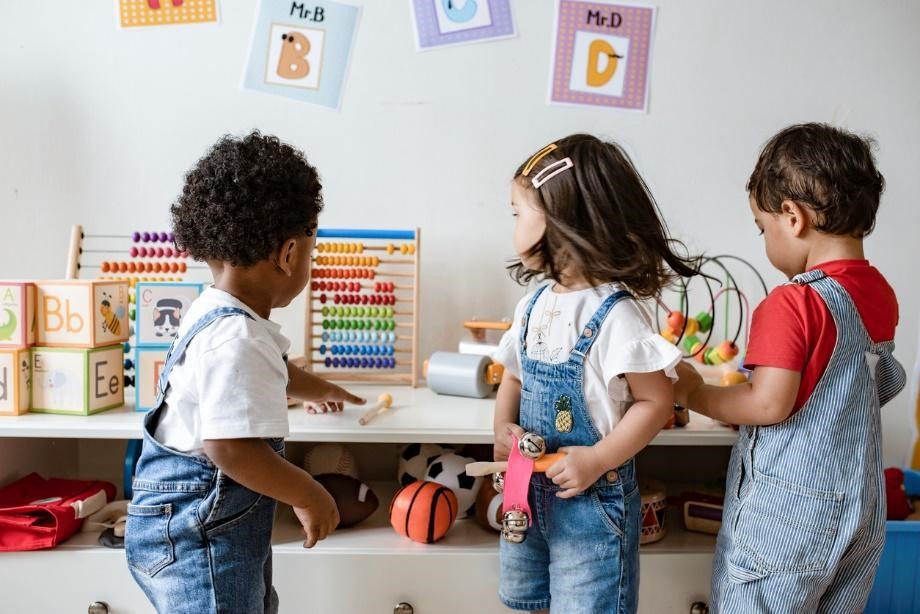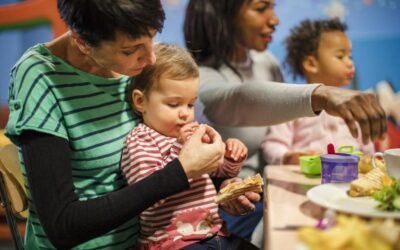Design the perfect space for learning and playing with age-appropriate materials and activities
Creating the ideal child care environment requires a thoughtful mix of fun and inspiring materials, developmentally appropriate activities, and quality caregivers who are invested and involved in the well-being of the children attending.
Infants and toddlers are at a crucial stage of development where they’re exploring the world around them and making valuable learning discoveries. A successful child care provider creates an environment and a learning plan that supports a child’s emotional, intellectual, and physical development in a safe and nurturing space. Create a plan to provide the best materials and activities to support the growth of infants and toddlers with the following guidelines and suggestions.
Plan out your learning centers
Your intent in designing learning centers should involve providing plenty of room for active play, as well as appropriate materials that are safe, fun, and inspire curiosity and creativity. Having well-defined, organized areas of interest helps foster independence, decision-making skills, and unstructured but supervised chances to play.
The following list can serve as a guide as you begin purchasing toys and activities for your child care program.
Reading: Reading is incredibly important for children of all ages. Children learn a lot through storytelling, and early exposure to books helps improve childhood literacy. Recommendations suggest that there should be at least 12 books for each age group in your care and no less than two books for each child in the group. Focus on easy, enjoyable stories that include different types of people, animals, objects, routines, and places.
Blocks: Toys that relate to building or stacking are good for motor skills and learning cause and effect. There should be enough blocks and building space to accommodate the number of children in the program. Having two sets of blocks for each age group is optimal. Traditional wooden blocks, cardboard brick blocks, foam blocks, fabric-covered soft blocks, and alphabet blocks are all great choices for young children.
Art: Children love creating things, and the act of doing so helps promote self-expression, creativity, and fine motor skills. Help toddlers make art by arranging projects that involve large washable markers or crayons, sidewalk chalk, tempera paint, chubby brushes, non-toxic play dough, construction paper, tape and glue sticks, or large colorful pompoms, stickers, and stamps.
Math and science: Introduce infants and toddlers to math and science through simple, play-based activities. Stacking cups, counting or sorting toys, rattles with different shapes and patterns, toy cash registers, and cradle gyms with hanging shapes are all helpful for teaching basic math skills. Science options should include items from nature, animal-shaped toys, plastic vegetables, infant play mats printed with animals, magnifying glasses, and other play materials that relate to space, nature, or the weather.
Music and movement: Music encourages active play and the development of rhythm and motor skills. There should be at least 10 musical toys available to children, with three for each age group. A music center could include musical mobiles, pull toys that make sounds when rolled, rattles or soft objects with bells inside, cymbals or clackers, musical toys with keys, and drums, xylophones, or bells. Encourage coordinated musical activities such as clapping, chanting nursery rhymes, following along in rhymes that include hand movements such as “Pat-a-Cake” or “Itsy-Bitsy Spider,” and dancing. Play recorded music, and hold babies as you bounce or sway to it.
Dramatic play: Pretending allows young children to develop new perspectives by role-playing different social situations or people. Provide three to five dolls, soft animals, toy telephones, or pots and pans for infants. Toddlers enjoy dress-up clothes, child-sized furniture or play kitchens, dolls, toy buildings and furnishings, and other materials that inspire pretend play.
Creating an educational and imaginative space is one of the fun parts of designing your child care area, but it can also be a challenge when you’re starting from scratch. Safety should always be your number one priority, followed by providing materials and activities that support the growth and development of the age groups represented by the children in your care.
The Virginia Infant & Toddler Specialist Network helps improve the quality of care for infants and toddlers through extensive resources, services, and education for caregivers. Learn more about how we can help you improve the standard of care.




